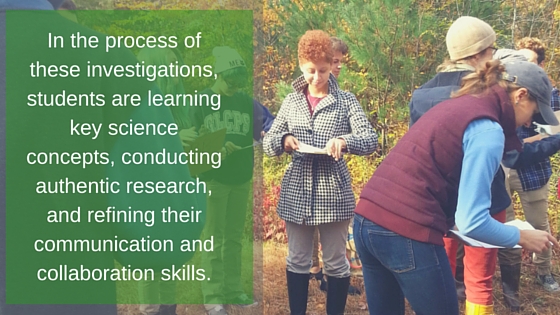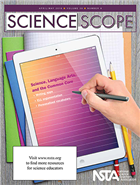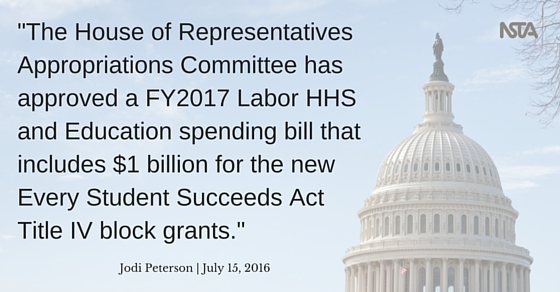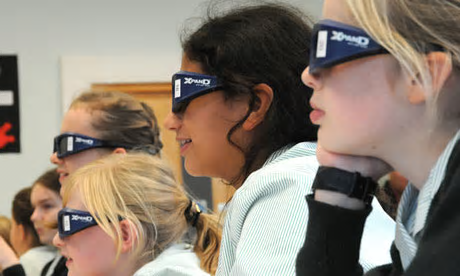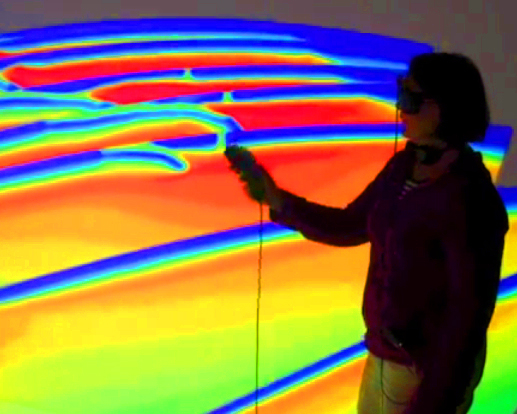Focus on Physics: The Equilibrium Rule—A Personal Discovery
By sstuckey
Posted on 2016-07-25
Building an Understanding of Physical Principles
Before college, I worked with master sign painter Burl Grey, who, like me, was passionate about science but didn’t study physics in high school. One day Burl asked which of the two ropes holding up our sign-painting scaffold (Figure 1) experienced more of the “stretching force” called tension. Burl twanged the rope near his end of the scaffold—like a guitar string—and I did the same with mine. Burl, who was heavier than me, reasoned that his rope should have more tension because it supported more weight. Hearing his rope twang at a higher pitch than mine reasonably confirmed that his rope experienced more tension.
Would it affect the tensions, we wondered, if I walked to the middle of the scaffold, toward Burl (Figure 2)? Burl’s rope would support more weight and have greater tension, we reasoned, and tension in my rope should decrease accordingly. To exaggerate the point, if we both stood together at one extreme end of the scaffold and leaned outward, the opposite end of the scaffold should rise like a seesaw, its rope going limp with no tension at all (Figure 3).
We agreed that my rope’s tension would decrease as I walked toward Burl—but would the decrease be compensated—exactly—by increased tension in Burl’s rope? If so, how would one rope “know” about changes in the other rope? The answer was beyond our understanding. I learned it only after leaving my sign-painting career for prep school, college, and graduate studies that immersed me in the world of physics.
The equilibrium rule
In my first physics class, I learned that things at rest, such as that scaffold, are in mechanical equilibrium. That is, all forces that act on it balance to zero. In mathematical notation, the equilibrium rule is ∑F = 0, with ∑ standing for “the sum of” and F for the forces that act on the object. In the case of Burl and me, our weights were 140 and 110 pounds, respectively (we didn’t talk newtons or kilograms back then). The weight of the scaffold was about 100 pounds. If we call the tensions in the ropes positive in direction (upward) and the weights negative (downward), then
∑F = Tension1 + Tension2
– 140 pounds – 110 pounds
– 100 pounds = 0.
Combining the weights of Burl, me, and the scaffold,
Tension1 + Tension2
– 350 pounds = 0.
Solving for tensions of both ropes,
Tension1 + Tension2 = 350 pounds.
Rope tensions must sum to 350 pounds (Figure 4). Can you see that
a gain in Tension1 by, say, 50 pounds would mean a loss in Tension2 of 50 pounds? To be in equilibrium, it has to be.
Consider another example (Figure 5). A 350-pound bear stands evenly on two weighing scales, each reading 175 pounds (half of 350).
Suppose the bear leans so that one scale reading increases by 50 pounds. This can’t happen unless the other scale reading decreases by
50 pounds. Only then will the combined readings add to 350 pounds. Likewise for the the supporting ropes of the scaffold. A 50-pound gain in one rope can only occur if accompanied by a 50-pound loss in the other. The answer lies in the mathematics: ∑F = 0.
Classroom activity
Place the opposite ends of a long horizontal plank on two bathroom scales on the floor (Figure 6). The sum of the two scale readings equals the weight of the plank. If you move the scales to different positions, still supporting the
plank, the readings still add to equal the weight of the plank. How nice! Now have two people stand on the plank near each end (Figure 7). The weight readings increase. How much? Enough so that the sum
of the weight readings equal the weights of the people and the plank. Again, the upward support forces of the springs in the scales (like the ropes holding the scaffold) equal the combined downward weights. Or, stated another way, the upward support forces minus the combined downward weights equal zero. The system is in equilibrium—balancing to zero even when the two people assume different positions along the plank.
Interestingly, the equilibrium rule applies not just to objects at rest but whenever any object or system of objects is not accelerating. Hence, a bowling ball rolling at constant velocity is in equilibrium—a state of no change. The ball rolls down the lane without a change in motion until it hits the pins, whereupon a change in its motion disrupts equilibrium. We say that objects at rest are in static equilibrium; objects moving at constant velocity (without acceleration) are in dynamic equilibrium. Whether objects are at rest
or steadily traveling in a straight-line path, ∑F = 0.
So, if you’re in an airplane moving at constant velocity, you know from
the equilibrium rule that the thrust of the engines must be equal and opposite to the air resistance that the airplane undergoes as it collides
with air molecules in its path (Figure 8). Only then will the horizontal forces on the plane sum to zero. Dynamic equilibrium occurs only if ∑F = 0. How about that!
When Nellie Newton pushes her desk across the floor at constant velocity, the equilibrium rule tells you that the amount of friction between the bottom of the desk’s legs and the floor exactly equals
Nellie’s push (Figure 9). Your knowledge of the amount of friction is simply an example of dynamic equilibrium. Cheers to that, for there’s a lot more you know when you know the laws of nature.
The equilibrium rule provides a reasoned way to view all things, whether in static (balancing rocks, steel beams in building construction) or dynamic (airplanes, bowling balls) equilibrium. For both of these types of mechanical equilibrium, all acting forces always balance to zero. In your further study, look for different forms of equilibrium, such as rotational, thermal, and chemical equilibrium. Examples of equilibrium are evident everywhere.
Paul G. Hewitt (pghewitt@aol.com) is the author of the popular textbook Conceptual Physics, 12th edition, and coauthor with his daughter Leslie and nephew John Suchocki of Conceptual Physical Science, 6th edition.
On the web
Related tutorial screencasts from www.hewittdrewit.com: 1. Equilibrium Rule: http://bit.ly/1T8XYZM; 2. Equilibrium Problems: http://bit.ly/27aKofE
Editor’s Note
This article was originally published in the Summer 2016 issue of The Science Teacher journal from the National Science Teachers Association (NSTA).
Get Involved With NSTA!
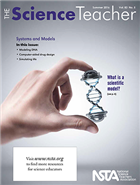 Join NSTA today and receive The Science Teacher, the peer-reviewed journal just for high school teachers; to write for the journal, see our Author Guidelines and Call for Papers; connect on the high school level science teaching list (members can sign up on the list server); or consider joining your peers at future NSTA conferences.
Join NSTA today and receive The Science Teacher, the peer-reviewed journal just for high school teachers; to write for the journal, see our Author Guidelines and Call for Papers; connect on the high school level science teaching list (members can sign up on the list server); or consider joining your peers at future NSTA conferences.
The mission of NSTA is to promote excellence and innovation in science teaching and learning for all.
Future NSTA Conferences
5th Annual STEM Forum & Expo, hosted by NSTA
- Denver, Colorado: July 27–29
2017 Area Conferences
- Baltimore, Maryland: October 5–7
- Milwaukee, Wisconsin: November 9–11
- New Orleans, Louisiana: November 30–December 2
National Conferences
- Los Angeles, California: March 30–April 2, 2017
- Atlanta, Georgia: March 15–18, 2018
- St. Louis, Missouri: April 11–14, 2019
- Boston, Massachusetts: March 26–29, 2020
- Chicago, Illinois: April 8–11, 2021
Follow NSTA
Ideas and information from NSTA's Summer K-12 journals
By Mary Bigelow
Posted on 2016-07-24
These issues are great additions to your summer reading list! Most of the lessons in these journals include a detailed chart connecting the lesson to the NGSS.
 Science and Children – From Molecules to Organisms
Science and Children – From Molecules to Organisms
The featured articles focus on developing a progression of learning for younger students.
- Native Plants and Seeds, Oh My! – Using a plant found in the school garden (milkweed), this lesson includes several parts on the basics of plants and investigations with native plants. Photographs show students at work.
- Who Is Your Champion? – With a focus on designs and models, students consider the question “What can we learn from plants and animals to help solve the problems we face in our lives?”
- Stalk It Up to Integrated Learning – Plant parts as food is the basis for this set of learning activities.
- Elementary Anatomy – Young students enjoy learning about themselves. This lesson for preschool students helps students learn about body parts they can’t see.
- Learning About Plants With STEAM – This year-long project incorporates the arts and sciences, using plants in an outdoor garden as a focus.
- Teaching Through Trade Books: The Purpose of Individual Parts and Processes – These two 5E lessons help K-2 and 3-5 students understand life cycles and the purposes of different parts of an organism.
- Formative Assessment Probes: Big and Small Seeds – Probes such as this one can be used in developing student understanding of science and engineering practices.
- The Early Years: Discovering Through Deconstruction – Students can learn from taking things apart to go from the whole to its parts. This lesson for young children deconstructs a fruit to learn about plant parts.
- Making the Transition to Three-Dimensional Teaching – Using the EQuIP rubric can help evaluate resources and align them to the NGSS.
- Science 101: Q: How Do We Distinguish Between Living and Nonliving Things? – This article for teachers has thoughts on this deceptively simple question.
For more on the content that provides a context for these projects and strategies see the SciLinks topics Butterflies, Characteristics of Living Things, Factors Affecting Plant Growth, Invasive Species, Life Cycles, Plants as Food, Plants with Seeds, Seed Germination, Structure of Seed Plants.
Continue for Science Scope and The Science Teacher
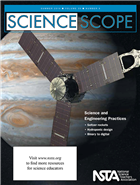 Science Scope – Science and Engineering Practices
Science Scope – Science and Engineering Practices
As you read the articles, take note of how the learning activities address science and engineering practices:
- Asking questions (for science) and defining problems (for engineering)
- Developing and using models
- Planning and carrying out investigations
- Analyzing and interpreting data
- Using mathematics and computational thinking
- Constructing explanations (for science) and designing solutions (for engineering)
- Engaging in argument from evidence
- Obtaining, evaluating, and communicating information
- Evaluating the Egg Drop: Using the EQuIp Rubric to Ensure Activities Meet the Next Generation Science Standards – See how a teacher updated a lesson to incorporate the three dimensions of NGSS, increasing student interest at the same time.
- Tried and True: Falling in Style – This 5E lesson is a variation on the egg-drop investigation, in which students design and test parachutes while learning about air resistance and gravity.
- WISEngineering Hydroponics: A Technology-Enhanced, Life Science Engineering Design Unit – Using the WISEngineering simulation, www.wisengineering.org students design a system for growing plants without soil. The article includes photographs of the projects and screenshots of the simulation.
- Engineering Technology for the Digital World – Students are very familiar with technology, but do they understand how their devices work? This activity introduces them to the binary system as they build and text a circuit board.
- Engineering Seltzer Rockets – Rather than expensive model rocket kits, students use simple materials to design and test rockets. This enables them to explore variables and conduct multiple tests.
- Bone Tissue Engineering: An Interactive Engineering Design Module – To address a real-world situation, students become biomedical engineers as they design and test a cranial mesh implant
- Teacher’s Toolkit: The New Standard in Technology Education: 3-D Design Class – Students get excited about using new technology, but the des
ign process is just as important as the technology. The authors note that “In order to benefit from 3-D printing technology in the classroom, students need to build a skill set in 3-D modeling” and include an outline of the process (see The Science Teacher for more on modeling.)
For more on the content that provides a context for these projects and strategies see the SciLinks topics Biomedical Engineer, Cellular Respiration, Force of Gravity, Forces and Motion, Hydroponics, Newton’s Laws, Photosynthesis, Skeletal System.
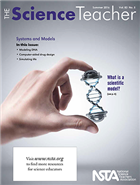 The Science Teacher – Systems and Models
The Science Teacher – Systems and Models
Students and parents often have a misconception of scientific models. The editor notes that “art projects, physical replicas, posters, and diagrams are not really scientific models, although they can be valuable learning experiences. ….a true model must be useful to explain natural phenomena and make predictions.”
- Crafting a Masterpiece – The author shares his experiences in using the EQuIP rubric to redesign lessons.
- Modeling DNA – Among other activities in this 5E lesson, students position their bodies to create a DNA model; they also use other materials to illustrate the structure and function of DNA.
- Explaining Ramps With Models – The authors described how this approach to learning resulted in more in-depth understanding. They include design strategies and photographs to illustrate student work.
- Computer-Aided Drug Design – Computers have enhanced the modeling process. Find out how students took on the role of “medicinal chemist” and used software simulations focused on cancer drugs to see the relationship between chemistry and biology.
- Simulating Life – This article looks at the emerging field of biomodeling. Students use simple materials (e.g., dice) and mathematics to analyze and predict bacteria movement.
- Connecting the Visible World With the Invisible – Throughout the year, students created and used particulate diagrams to represent their knowledge of elements, mixtures, and compounds.
- Science 2.0: Soaring in a Digital Ecosystem – The authors describe a taxonomy of technology processes: substitution, augmentation, modification, and redefinition. The latter two are part of how technology can transform a classroom.
- Focus on Physics: The Equilibrium Rule—A Personal Discovery – Here’s a refresher on the topic, with illustrations and examples.
For more on the content that provides a context for these projects and strategies see the SciLinks topics Acceleration, Balanced and Unbalanced Forces, Compounds, DNA Structure and Function, Elements, Equilibrium, Mixtures, Motion, Velocity
These issues are great additions to your summer reading list! Most of the lessons in these journals include a detailed chart connecting the lesson to the NGSS.
 Science and Children – From Molecules to Organisms
Science and Children – From Molecules to Organisms
Soaring in a Digital Ecosystem
By sstuckey
Posted on 2016-07-21
This column regularly describes digital tools to help teachers make learning more personal and effective for all students. When these tools converge, they create a sort of digital ecosystem designed to make students more collaborative and innovative, skills essential for success in today’s world. But are your students truly using digital technology to its maximum benefit?
The SAMR model
Our efforts toward digital convergence are based on the Substitution  Augmentation Modification Redefinition (SAMR) model (http://bit.ly/1mFgc1l) (see box), which leads to higher-order technology in the classroom. Used at a low level, technology merely serves as a substitution—for example, using a word processor instead of paper and pencil to write a conclusion.
Augmentation Modification Redefinition (SAMR) model (http://bit.ly/1mFgc1l) (see box), which leads to higher-order technology in the classroom. Used at a low level, technology merely serves as a substitution—for example, using a word processor instead of paper and pencil to write a conclusion.
The next level is augmentation, in which technology improves on a learning task similar to what students could do without the technology, such as using the formatting tools in a word processor to highlight areas of interest. Much of classroom technology falls into these two categories, including scientific probes and graphing calculators (www.desmos.com). Our goal is to move on to the next levels of technology use: modification and redefinition of student work to demonstrate understanding.
Getting to Modification and Redefinition
To help you look at your lessons through a SAMR lens, let’s put a sample activity—a traditional chemical reactions experiment—through the SAMR continuum. First, students might use technology to substitute for an analog tool, such as using an online stopwatch (e.g., www.online-stopwatch.com)—instead of an actual stopwatch to time a reaction. To compare the physical and chemical properties of compounds being used in their reactions, students might substitute online reference guides (e.g., www.webelements.com, www.chemicalelements.com) for the paper periodic tables crammed into their backpacks or binders.
The next step up, augmentation, includes tools that give students time to analyze data rather than merely collecting it. Examples include using graphing software (e.g., https://plot.ly/plot, www.onlinecharttool.com and www.chartle.net) and data-collecting probes (such as those found at www.pasco.com and www.vernier.com) to quickly gather data about the chemical reactions so students can focus on describing the reorganization of matter in their products to evidence learning.
Traditionally, we may have asked students to complete a worksheet with data tables and analysis questions, a task that could be substituted by an online Google Doc or Form. But now we can modify this task—advancing to the next level—by asking students to create a podcast (using, for example, http://vocaroo.com) that describes what they saw as the chemical reaction occurred. We could also ask them to video (using, for example, www.wevideo.com or www.magisto.com) what they saw, narrating in voiceover how bonds are breaking and new ones are being formed. With the right device, they could even mark up that video (using, for example, www.coachmyvideo.mobi or www.coachseye.com). Turning in such an assignment could be as simple as sharing a URL or dropping a file into a shared folder (e.g., https://apps.google.com, www.dropbox.com).
But why not completely redefine how student work is assessed and evaluated by asking students to critique each other’s work (https://voicethread.com) and extend the thinking of the student who created it? This type of collaboration and discussion, previously only available in text-based discussion boards, allows students to build and grow their learning network and share their innovative products with peers in a meaningful way.
Conclusion
Digital convergence really means increased engagement and higher-order thinking in our students. Look at the technology available in your own classroom and ask whether students are using it to reach new heights in their learning.
Ben Smith (ben@edtechinnovators.com) is a physics teacher in Red Lion, Pennsylvania; and Jared Mader (jared@edtechinnovators.com) is the director of technology for the Lincoln Intermediate Unit in New Oxford, Pennsylvania. They conduct teacher workshops on technology in the classroom nationwide.
Get Involved With NSTA!
 Join NSTA today and receive The Science Teacher, the peer-reviewed journal just for high school teachers; to write for the journal, see our Author Guidelines and Call for Papers; connect on the high school level science teaching list (members can sign up on the list server); or consider joining your peers at future NSTA conferences.
Join NSTA today and receive The Science Teacher, the peer-reviewed journal just for high school teachers; to write for the journal, see our Author Guidelines and Call for Papers; connect on the high school level science teaching list (members can sign up on the list server); or consider joining your peers at future NSTA conferences.
The mission of NSTA is to promote excellence and innovation in science teaching and learning for all.
Future NSTA Conferences
5th Annual STEM Forum & Expo, hosted by NSTA
- Denver, Colorado: July 27–29
2017 Area Conferences
- Baltimore, Maryland: October 5–7
- Milwaukee, Wisconsin: November 9–11
- New Orleans, Louisiana: November 30–December 2
National Conferences
- Los Angeles, California: March 30–April 2, 2017
- Atlanta, Georgia: March 15–18, 2018
- St. Louis, Missouri: April 11–14, 2019
- Boston, Massachusetts: March 26–29, 2020
- Chicago, Illinois: April 8–11, 2021
Follow NSTA
This column regularly describes digital tools to help teachers make learning more personal and effective for all students. When these tools converge, they create a sort of digital ecosystem designed to make students more collaborative and innovative, skills essential for success in today’s world. But are your students truly using digital technology to its maximum benefit?
Place-Based Learning in Middle School: Putting Scientific Principles to Work in your Community
By Guest Blogger
Posted on 2016-07-20
“When we try to pick out anything by itself, we find it hitched to everything else in the Universe.” -John Muir, My First Summer in the Sierra, 1911.
We hope that you are enjoying your summer! As teachers, we realize that your mind is never far from your classroom, even if your body is lounging on a chair next to *insert appropriate body of water here*. As science teachers, especially, even the sounds of waves and splashing children have entirely different meaning to us than to those in other walks of life. You might hear water hitting the beach and start pondering frequency, wavelength, and longshore drift and before you know it your mind starts generating lesson plans. Teachers are constantly mining personal experiences for ideas to help students connect what they learn to the world around them.
Making these connections is infinitely easier for our students if we are able to take them beyond the confines of the schoolroom. While the majority of us would hesitate to invite our students on summer vacation with us, we work hard to provide real-world, authentic learning opportunities for them. When students embark on a nature walk around the school grounds, enjoy a guest speaker from the local community, experience a well-planned outdoor education trip, or gather data for citizen-scientist programs science concepts come alive in a way that even the best textbooks can never match.
Many teachers are taking this experiential learning a step further and challenging their students to advance beyond experience into action through Place-Based Learning (PBL) opportunities. The intent of PBL is to bring students’ attention to a community problem, develop partnerships within the community and beyond, and connect students to their environment on an emotional as well as intellectual level. In the process of these investigations, students are learning key science concepts, conducting authentic research, and refining their communication and collaboration skills.
Middle school students at the Global Learning Charter Public School in New Bedford, MA researched animals in the local zoo during a unit on ecology and environmental standards. They shared their reports with the Buttonwood Zoo and that material was later used by the zoo to create conservation signage for zoo patrons. These same students, now in high school, became concerned about plastic pollution in local waterways and did a number of presentations on the ‘Perils of Plastics” to the school and also the New Bedford community on Save the Planet day at the Buttonwood Zoo. The students have also formed a partnership with the Buzzards Bay Coalition (BBC) to create games and pamphlets to educate the community about the life cycles and local habitats for American Eels. They continue to help monitor the health of the Acushnet River and present student-designed lessons on water quality and the American Eel at BBC local events and at the zoo.
As shown in the above examples, PBL can have long-term and far-reaching benefits for students, schools, and communities. However, many teachers are hesitant to embark on these projects due to time constraints, pressures from standardized test curriculums, and lack of funding for buses and program fees. They are not given mentors who have used PBL and can often be left to design and struggle with the planning on their own. If teachers are to embrace PBL they need help in doing so.
If you are interested in incorporating place-based learning into your lessons, we suggest that you start small, work with school families and administration, and gradually work to develop ties and partnerships with community members. Successful relationships with the community are the foundation of successful PBL. Encouraging students to enter into local and national contests accesses their natural competitive spirit and helps them to develop partnerships with organizations to obtain the resources to address the problems they have identified. For example, to further the American Eels project described above, students successfully applied to Dr. Jane Goodall’s Roots and Shoots program and the school now has two Roots and Shoots clubs on campus.
Steps to Incorporating Place-Based Learning
1) Select a local environmental issue that is interesting and relevant to you, your students, and the community.
2) Plan an inquiry project for your students that connects the work of the community organization with your standards and their local realities.
3) Identify parents, local or national organizations that address the issue and connect with them in person and online. Ask them to speak with your students and provide learning opportunities for them.
4) Include an action component in the project plan, i.e. personal change, public awareness campaign, art installation, etc. Some organizations have campaigns or projects already established and will welcome your assistance.
If you have experience with place-based learning, please share your stories and advice for other teachers in the comments below.
Diana Cost and Elizabeth Orlandi are members of NSTA’s Middle Level Science Teaching Committee. We would like to give credit to and thank Dr. Jesse Bazzul, PhD, for developing the STEPs to Place-Based Learning. His guidance was invaluable to us in crafting this program.
Join NSTA today and receive Science Scope, the peer-reviewed journal just for middle school teachers; connect on the middle level science teaching list (members can sign up on the list server); or consider joining your peers for Meet Me in the Middle Day (MMITM) at the National Conference on Science Education in Los Angeles in the spring of 2017.
The mission of NSTA is to promote excellence and innovation in science teaching and learning for all.
Future NSTA Conferences
NGSS Workshops
2016 STEM Forum & Expo, hosted by NSTA
2016 Area Conferences
2017 National Conference
Follow NSTA
Changing grade levels
By Mary Bigelow
Posted on 2016-07-16
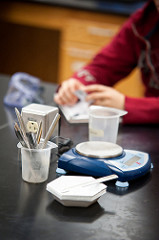 Next year there will be an opening in the high school science department. Although I love teaching middle school, I’m tempted by the opportunity to try something different and use more of what I majored in (chemistry). What advantages and disadvantages should I consider?—C., New Jersey
Next year there will be an opening in the high school science department. Although I love teaching middle school, I’m tempted by the opportunity to try something different and use more of what I majored in (chemistry). What advantages and disadvantages should I consider?—C., New Jersey
Taking on new subjects or grade levels can be exciting and professionally rejuvenating. It can also be a lot of work, almost like starting over.
I was in a similar circumstance with an opportunity to switch to a high school program. Reflecting on the experience, I think that being a middle school teacher is excellent preparation for high school. My middle school experience gave me a relaxed, off-beat sense of humor and helped me to deal with high schoolers who needed different instructional approaches or more time to learn a concept. Engaging with high schoolers in spirited discussions and in high-level investigations was intellectually exhilarating (although I still have a soft spot for middle schoolers). But I don’t regret taking on a rewarding challenge that enabled me to grow professionally.
You’ll notice some differences in the students. Even though they try hard to act like adults, most middle schoolers are still basically kids, with high levels of energy and enthusiasm. The challenge is channeling their energy and enthusiasm, and since most of them like science, this isn’t hard to do. High schoolers on the other hand often seem to be distracted by non-classroom issues, such as social media, their personal lives, extracurricular activities, and jobs. They have internalized what school is supposed to be like and may balk at doing something different. Generating energy and enthusiasm was often the challenge (I had to get used to eye-rolls and heavy sighs). But I did enjoy interacting with the older students and helping them become more independent learners.
Assuming you’re in the same district or attendance area, you’ll know many of your students from their middle years. When these students say they have never heard of atoms or never had to write a lab report, you can remind them that you were there. But you still may have to reteach skills you thought they had mastered such as organizing, notetaking, graphing, and technical writing.
There are also some practical considerations as you make your decision:
- Be sure you have the appropriate credentials for the science course and electives taught at the high school.
- Visit the high school ahead of time and look at the environment from the perspective of a teacher there. You should check out your potential classroom/lab, the technology, safety equipment, and other resources. If the classroom/lab is physically different from your middle school environment, you may need to modify some of your instructional and classroom management procedures.
- Ask if the district safety officer will be available to assist in inventorying and any cleanup of chemicals or other materials.
- Ask for a copy of the curriculum, textbook, online materials, and other resources to review ahead of time. Your collection of lessons, assessments, and materials may no longer be appropriate, so you’ll have to spend time creating or adapting materials and lab investigations.
Middle schools often have professional learning communities or teams with common planning time. However, the high school schedule might not allow opportunities for teacher collaboration during the school day.
As you change schools, you’ll have to get used to new schedules, a new culture, and a new group of colleagues. It would be helpful to have the student and faculty handbook ahead of time and a go-to person to answer questions and share resources and information. Try to find a colleague who also changed teaching positions and pick his or her brain about what to expect.
It’s a humbling experience as a veteran teacher to realize you may not have all of the answers right away in a new situation and that you’ll make some mistakes. Give yourself permission to learn along with the students.
But you already have a strong foundation in the subject, and you’ll be able to help students see the connections between chemistry and other subjects. You already have a repertoire of strategies for instruction, assessments, lab safety, and classroom management. And if you decide to make the switch, you’ll have the chance to clean out your file drawers!
Photo: http://www.flickr.com/photos/jeremywilburn/5229139935/
Legislative Update
Update on ESSA; Good News for STEM and FY2017 Appropriations
By Jodi Peterson
Posted on 2016-07-15
July 14, 2016: Congress is set to adjourn for the summer and will return after Labor Day. Before leaving town though there was a flurry of activity around appropriations for FY2017 programs and career and technical education. And the political drama continues as Education Secretary King answers questions from key Congressional Republicans over implementation of the Every Student Succeeds Act.
The good news for STEM: The House of Representatives Appropriations Committee has approved a FY2017 Labor HHS and Education spending bill that includes $1 billion for the new Every Student Succeeds Act Title IV block grants. This amount is $500 million above the President’s budget request and $700 million above the Senate funding ($300m). The program is authorized at $1.65 billion in ESSA.
The ESSA Student Support and Academic Achievement State Grants would provide flexible funds to every school district to expand access to a well-rounded education, improve school conditions, and improve the use of technology. As reported in previous NSTA Legislative Updates, under Title IV districts can elect to use funds to provide students with a well-rounded education with programs that improve instruction and student engagement in STEM, expand STEM courses, pay for the participation of students in STEM nonprofit competitions, provide hands-on learning opportunities in STEM, integrate other academic subjects into STEM subject programs, create STEM specialty schools, integrate classroom-based and afterschool and informal STEM instruction, and expand environmental education courses.
(Read more about the House funding for the ESSA Title IV block grant here and here.)
The House funding bill also reduces the State grants for ESSA teacher quality (Title II) by $400 million of the requested amount, bringing the program to about $1.9 billion. The Senate version reduces this program by about $200m.
Here’s the bad news. Although both the Senate and House have approved their separate funding bills for education, it is highly unlikely that any final appropriations bills for FY2017, which starts on Oct.1, will make it through both chambers. There are more than 12 funding bills, including education, still in play and a limited Congressional calendar in September (before they adjourn again for the election). And let’s not forget election year politics.
With this in mind, talk is now turning to a possible spending stop gap measure, known as a continuing resolution (CR), which would fund the government past Oct. 1 and also allow Congress to put together an omnibus bill that would roll the 12 separate funding bills into one package. Here’s the good news: the basis for an omnibus bill will likely be the 12 bills written by the House and Senate, which includes the $1 billion allocated for the aforementioned ESSA Title IV block grants.
And even better news: Report language accompanying the House appropriations bill, which clarifies Congressional intent, clearly calls out STEM and Computer Science Education, with legislators noting that funds available under this program “may be used by States and school districts to provide or strengthen instruction in STEM fields, including computer science.” The Committee report also recommends no separate funding for the competitive Computer Science for All Development Grants, a priority for the Administration and a coalition of moderate Democrats.
Implementation of the Every Student Succeeds Act
In recent House and Senate hearings on ESSA implementation, Education Secretary John King faced serious questions from Republican lawmakers who believe the Department of Education is overstepping its authority in implementing the new law. Issues of concern include the Department proposal that would require states and schools to create a summative rating for accountability purposes and the timeline for transitioning to ESSA (the first full year of ESSA is 2017-18, and schools may have to rely on 2016-17 data to be used to identify and intervene with low performing schools).
Proposed language that would ensure that federal Title I dollars supplement and do not supplant state and local dollars is also a huge issue.
Many Republicans and other critics (including the unions) have voiced concerns that the department is not following the intent of the law with draft supplement-not-supplant regulatory language that they believe would could require districts to use school-level expenditures tests to show equal spending and require monitoring teacher salaries, which could lead to teacher reassignment and changes in teacher hiring practices (and disruptions to collective bargaining). King maintains the Department will be “vigilant” in ensuring that interventions continue in the lowest-performing schools, and that federal dollars are truly supplemental to state and local funding.
In other ESSA news, the Education Department has issued draft regulations for an innovative assessment pilot that will allow up to seven states to experiment with new tests (including science tests) that can eventually be used throughout the state for accountability purposes. Read more here about the tests and here about the draft regulations.
The Education Department also released proposed regulations on assessments.
House Passes Rewrite of Career and Technical Education Law (Perkins Act)
On July 7 the House Committee on Education and the Workforce unanimously approved H.R. 5587, the Strengthening Career and Technical Education for the 21st Century Act, legislation that reauthorizes and reforms the Carl D. Perkins Career and Technical Education Act and will help more Americans enter the workforce with the skills they need to compete for high-skilled, in-demand jobs.
The new law will give states more flexibility over how they spend federal money and allows states more control on measuring the success of their programs. It also aligns performance standards for Perkins programs with the Every Student Succeeds Act and the Workforce Innovation and Opportunity Act. Senate education leaders have indicated they would like to see Perkins reauthorized soon, so a similar bill may be introduced later this year in the Senate.
Republicans and Democrats Party Platforms and Priorities for Education
Both parties have released drafts of their party platforms, which include a number of key priorities for K-12 education.
Here is an excerpt from the Democratic Platform on teaching and learning and STEM Education:
“Democrats will launch a nation
al campaign to recruit and retain high-quality teachers, and we will ensure that teachers receive the tools and ongoing professional development they need to succeed in the classroom and provide our children with a world-class education. We also must lift up and trust our educators, continually build their capacity, and ensure that our schools are safe, welcoming, collaborative, and well-resourced places for our students, educators, and communities. We will invest in high-quality STEM classes, community schools, computer science education, arts education, and expand linked learning models and career pathways.”
Here is an excerpt from the Republican Platform on teaching and learning and STEM Education:
We applaud America’s great teachers, who should be protected against frivolous litigation and should be able to take reasonable actions to maintain discipline and order in the classroom. We support legislation that will correct the current law provision which defines a “Highly Qualified Teacher” merely by his or her credentials, not results in the classroom. We urge school districts to make use of teaching talent in business, STEM fields, and in the military, especially among our returning veterans. Rigid tenure systems based on the “last in, first out” policy should be replaced with a merit-based approach that can attract fresh talent and dedication to the classroom. All personnel who interact with school children should pass background checks and be held to the highest standards of personal conduct.
And finally, the National Science Foundation’s Directorate for Education and Human Resources has launched a nationwide search for a Division Director of the Division of Undergraduate Education (DUE). The Division Director of DUE oversees a substantial portfolio of research, development, and education programs related to undergraduate education, and works with other leaders at NSF and the community to advance STEM and STEM education. Further information about the position can be found here: http://www.nsf.gov/pubs/2016/nsf16111/nsf16111.jsp?org=NSF
Jodi Peterson is Assistant Executive Director of Legislative Affairs for the National Science Teachers Association (NSTA) and Chair of the STEM Education Coalition. e-mail Peterson at jpeterson@nsta.org; follow her on Twitter at @stemedadvocate.
Follow NSTA
3D Brings Science to Life
By Edwin P. Christmann
Posted on 2016-07-15
Middle school children are inquisitive and enjoy classroom opportunities to learn visually. Subsequently, an option worth consideration is an application of technology known as 3D. It’s similar to the 3D technology that is used in movie theaters and is designed to enhance visualization of pairs of images and gives users a greater sense of depth perception.
For nearly 150 years, stereoscopes have been used for looking at images that depict left-eye and right-eye views of the same object; culminating into a single three-dimensional image. Subsequently, when viewing the image with special projection hardware and eyewear, a typical stereoscope provides each eye with a lens that makes the image seen through it appear larger and more distant, resulting in the illusion of depth.
Recent Advances in technology have led to much more sophisticated ways of projecting the third dimension. For example, Data Light Processing (DLP) technology creates a stunning picture and is used in contemporary projectors. DLP technology is extremely fast, and projects two images on the screen at the same time, i.e., one for each eye. As a tool for conceiving the image, 3D glasses are used to combine the two images into 3D and can be purchased from a variety of projector manufacturers, e.g., InFocus, Texas Instruments, etc.
In this age of technology, even with the most determined efforts to differentiate classroom instruction, it is common for teachers to face kids who are difficult to keep on task. However, with 3D technology and at a cost that most schools can afford, a sudden vision of a brain or a heart via 3D technology can motivate students with an authentic experience of the relationships between individual cell parts and the structures and function of the heart [http://www.theguardian.com/classroom-innovation/3d-lessons-in-schools].
By presenting students with problem-solving skills, using 3D technology can give students the opportunity to go beyond the “Knowledge-level,”and reach the “Analysis-level!” For example, students can take a virtual trip down through the crust of the earth and travel its inner core. Along the way, students can examine changes in density, mass, and temperature. With 3D technology, students can go beyond memorization and travel on an exciting journey through nature, which can reveal folded mountains and massive sea trenches; almost as if it’s really happening before your eyes [https://sciencenode.org/feature/3d-tectonic-modeling-answers-age-old-geology-question.php]. So what do teachers need to get started?
Different Projectors and Software Packages
There are a variety of 3D software packages available for science teaching. Recently, projector manufacturers have begun rolling out 3D models targeting the needs of classrooms, while makers of 3D content and accessories are responding to schools by creating products to meet the needs of a growing market. For example, the 3D capability of the 2300-lumen projector from ViewSonic (www.viewsonic.com) is available for around $500. Here is a list of manufactures who carry 3D projectors:
www.mitsubishi-presentations.com
Once a projector has been purchased, teachers can get software to integrate 3D software, e.g., [http://en.softonic.com/s/free-3d-science-animation-software]. An excellent website worth visiting is Cyber Science 3D, which offers content that spans science content areas. Teachers can use the content in a lecture environment to demonstrate terms, labels, and spatial relationships between objects in the 3D simulations [http://cyberscience3d.com/3d-content-library/]. If interested in giving 3D a try, Cyberscience3D offers a trial where you can dissect a cactus. Access this site and experience the benefits of 3D for classroom instruction, i.e., [http://cyberscience3d.com/free-trial/]. In addition, a variety of 3D models are available for classroom use in the following areas:
Once 3D software is selected, special 3D glasses are needed, which can range in price from around $7.99 to over $200. Depending on your budget and what you want to use, consider durability when purchasing glasses [ http://3d-tv-glasses-review.toptenreviews.com].
The integration of 3D technology into science instruction gives students an opportunity to visualize ideas and have these ideas serve as virtual models for real-life scenarios. In essence, 3D technology gives teachers an opportunity to bring the future to our students today!
Authors
Mervyn J. Wighting (mervwig@regent.edu) is a professor of education at Regent University in Virginia Beach, Virginia. Edwin P. Christmann (edwin.christmann@sru.edu) is a professor, chairman of the secondary education department, and graduate coordinator of the mathematics and science teaching program at Slippery Rock University in Slippery Rock, Pennsylvania.
Middle school children are inquisitive and enjoy classroom opportunities to learn visually. Subsequently, an option worth consideration is an application of technology known as 3D. It’s similar to the 3D technology that is used in movie theaters and is designed to enhance visualization of pairs of images and gives users a greater sense of depth perception.
Write Grant Proposals That Win
By Carole Hayward
Posted on 2016-07-12
A successful grant application can provide you with the funding you need to do exciting new activities with your students. The only problem is that grant writing is an art form of its own. There’s a new NSTA Press book that can help.
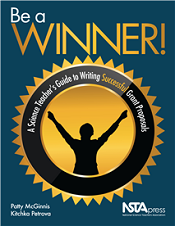 Be a Winner! A Science Teacher’s Guide to Writing Successful Grant Proposals by Patty McGinnis and Kitchka Petrova offers practical tips and strategies to help you write winning proposals.
Be a Winner! A Science Teacher’s Guide to Writing Successful Grant Proposals by Patty McGinnis and Kitchka Petrova offers practical tips and strategies to help you write winning proposals.
“As a science educator, you are concerned with the state of science education in your K-12 schools, and you understand the importance of facilitating your students’ science learning through the science and engineering practices identified in the Next Generation Science Standards (NGSS). Unfortunately, funds for purchasing materials are not always available in schools, thus requiring you to seek outside funding opportunities. Given the economic situation of many school districts, it is more imperative than ever to master the art of grant proposal writing to secure funds for innovative classroom projects,” write McGinnis and Petrova.
How do you even get started? First, you need to come up with a strong idea.
The authors ask readers to consider an important question: “What is your dream for your classroom, school, science department, or community?” This question will lead you think about what you want to accomplish. Next, you will think about what resources are already available for you to tap into before you even begin the grant process.
Just like any scientific activity, there are steps and standards to follow in order to achieve the goal. The authors do an excellent job of breaking down the chunks of the grant proposal process to make it appear less daunting.
Using McGinnis’ and Petrova’s tips to organize your thinking, clarify your objectives, create an elevator speech, and build the required components of the proposal will increase your ability to feel confident and prepared when seeking grant funding. The book even offers suggestions to help you create project ideas that align with the NGSS standards.
“The inclusion of the NGSS performance expectations in your proposal will help your students achieve high standards and increase the value of your proposal,” write McGinnis and Petrova.
Be a Winner! offers a listing of grants and additional grant writing resources and also provides advice about managing your grant-funded project.
This book is for teachers new to grant writing and for pros who want to increase their efficacy.
Get started writing winning grant proposals today! Check out the sample chapter “Getting Started: May the FORCE Be With You! This book is also available as an e-book.
Follow NSTA
Save
Save
A successful grant application can provide you with the funding you need to do exciting new activities with your students. The only problem is that grant writing is an art form of its own. There’s a new NSTA Press book that can help.
Water play…exploration…science inquiry
By Peggy Ashbrook
Posted on 2016-07-11
 Water explorations are a popular in early childhood programs during the summer. Exuberant water explorations can happen outdoors. The experience of wetness is enjoyable and clothes that get wet accidentally can dry on the child rather than having to be changed. Natural materials such as leaves and twigs can be incorporated into the exploration.
Water explorations are a popular in early childhood programs during the summer. Exuberant water explorations can happen outdoors. The experience of wetness is enjoyable and clothes that get wet accidentally can dry on the child rather than having to be changed. Natural materials such as leaves and twigs can be incorporated into the exploration.
To keep the water experiences enjoyable, meaningful and a powerful learning opportunity, take a look at these resources.
 Play is part of every science exploration. Science learning begins very early as children explore the properties of matter and how they can affect it through their play. “Five Essentials to Meaningful Play,” Marcia Nell and Walter Drew’s online column in NAEYC for families, can help other adults understand how children are learning science concepts and much more through their water play. Their book, From Play to Practice: Connecting Teachers’ Play to Children’s Learning is another valuable resource.
Play is part of every science exploration. Science learning begins very early as children explore the properties of matter and how they can affect it through their play. “Five Essentials to Meaningful Play,” Marcia Nell and Walter Drew’s online column in NAEYC for families, can help other adults understand how children are learning science concepts and much more through their water play. Their book, From Play to Practice: Connecting Teachers’ Play to Children’s Learning is another valuable resource.
 Children learn more each time they repeat an experience. Adults who embrace children’s curiosity and encourage questions and problem-solving support children’s learning. Water play can become an inquiry into the properties of water when adults provide additional materials and help children reflect on their observations. Science inquiry is more than single activities about science topics or concepts. The Young Scientist series book, Exploring Water with Young Children, by Karen Worth and Ingrid Chalufour (Redleaf
Children learn more each time they repeat an experience. Adults who embrace children’s curiosity and encourage questions and problem-solving support children’s learning. Water play can become an inquiry into the properties of water when adults provide additional materials and help children reflect on their observations. Science inquiry is more than single activities about science topics or concepts. The Young Scientist series book, Exploring Water with Young Children, by Karen Worth and Ingrid Chalufour (Redleaf  Press) is a guide for using water to help children use the practices of science, investigate flow and how water affects objects. There is also guidance on developing scientific dispositions of eagerness to learn and curiosity. I think it is also helpful in supporting teachers who have not yet taught science concepts, topics, or the nature of science.
Press) is a guide for using water to help children use the practices of science, investigate flow and how water affects objects. There is also guidance on developing scientific dispositions of eagerness to learn and curiosity. I think it is also helpful in supporting teachers who have not yet taught science concepts, topics, or the nature of science.
 NAEYC provides free online access to the article “Promoting Children’s Science Inquiry and Learning Through Water Investigations” by Cindy Hoisington, Ingrid Chalufour, Jeff Winokur, and Nancy Clark-Chiarelli from the October/November 2014 issue of Teaching Young Children and September 2014 issue of Young Children. Read about how to facilitate direct experiences that promote conceptual learning related to water. Learn how to ask questions about phenomena that are connected to concepts and interesting to children, and questions that stimulate children’s inquiry and investigation rather than suggest “correct” answers.
NAEYC provides free online access to the article “Promoting Children’s Science Inquiry and Learning Through Water Investigations” by Cindy Hoisington, Ingrid Chalufour, Jeff Winokur, and Nancy Clark-Chiarelli from the October/November 2014 issue of Teaching Young Children and September 2014 issue of Young Children. Read about how to facilitate direct experiences that promote conceptual learning related to water. Learn how to ask questions about phenomena that are connected to concepts and interesting to children, and questions that stimulate children’s inquiry and investigation rather than suggest “correct” answers.
 The National Science Teachers Association’s (NSTA) position statement on Early Childhood Science Education was endorsed by the National Association for the Education of Young Children (NAEYC). The statement affirms that “Effective science investigations can deeply engage young children for extended periods of time, beyond a single activity or session.” It also offers guidance to educators in principles and declarations.
The National Science Teachers Association’s (NSTA) position statement on Early Childhood Science Education was endorsed by the National Association for the Education of Young Children (NAEYC). The statement affirms that “Effective science investigations can deeply engage young children for extended periods of time, beyond a single activity or session.” It also offers guidance to educators in principles and declarations.
Two examples:
NSTA identifies the following key principles to guide the learning of science among young children.
- Adults play a central and important role in helping young children learn science.
Everyday life is rich with science experiences, but these experiences can best contribute to science learning when an adult prepares the environment for science exploration, focuses children’s observations, and provides time to talk about what was done and seen (NAEYC 2013, p. 18). It is important that adults support children’s play and also direct their attention, structure their experiences, support their learning attempts, and regulate the complexity and difficulty of levels of information (NRC 2007, p. 3). It’s equally important for adults to look for signs from children and adjust the learning experiences to support their curiosity, learning, and understanding. [See the document online for references.]
Declarations
NSTA recommends that teachers and other education providers who support children’s learning in any early childhood setting should
- tap into, guide, and focus children’s natural interests and abilities through carefully planned open-ended, inquiry-based explorations;
 Another resource for expanding a session at the water center into science inquiry is the description of the science and engineering practices in Rodger W. Bybee’s article “Scientific and Engineering Practices in K–12 Classrooms Understanding A Framework for K–12 Science Education” in the December 2011 issue of Science and Children. It is free to read online. Here is a list of the eight practices of science and engineering that the Framework identifies as essential for all students to learn:
Another resource for expanding a session at the water center into science inquiry is the description of the science and engineering practices in Rodger W. Bybee’s article “Scientific and Engineering Practices in K–12 Classrooms Understanding A Framework for K–12 Science Education” in the December 2011 issue of Science and Children. It is free to read online. Here is a list of the eight practices of science and engineering that the Framework identifies as essential for all students to learn:
1. Asking questions (for science) and defining problems (for engineering)
2. Developing and using models
3. Planning and carrying out investigations
4. Analyzing and interpreting data
5. Using mathematics and computational thinking
6. Constructing explanations (for science) and designing solutions (for engineering)
7. Engaging in argument from evidence
8. Obtaining, evaluating, and communicating information.
In my book, Science Learning in the Early Years, there are four column chapters discussing water exploration:
Chapter 24—Water Works, updated from the July 2007 Science and Children
Chapter 33—Adding Up the Rain, updated from the July 2009 Science and Children
Chapter 42—Ongoing inquiry, investigating water, updated from the February 2011 Science and Children
Chapter 52—Water Leaves “Footprints,” updated from the April 2013 Science and Children
I also discussed aspects of water play as part of the NSTA Virtual Conference, Engaging Students in Science: PreK-6.
 The challenges we face in providing effective science education for young children vary from location to location and program to program. In one school the deep sink that allows teachers to fill buckets or small tubs of water only has a hot water option. Those teachers have to plan ahead to fill jugs of water at the end of the day so it will cool down enough for children to work in the following day. Families can be very concerned about children’s clothing getting wet or muddy. We can’t take this lightly—they may not have easy access to laundry facilities or extra sets of clothing. Some programs invest in smocks that cover most of children’s clothing. Other programs use large plastic bags cut open into a smock shape for older children and with close supervision. Programs that do not have a “science budget” make interesting tools for water exploration out of empty milk jugs, dollar store purchases or donations of recyclable containers and turkey basters from families. Leaves and twigs from safe plants make interesting tools. One program that had just a single water table for 5 classrooms bought large shallow storage tubs to use on table tops and even on the ground outside.
The challenges we face in providing effective science education for young children vary from location to location and program to program. In one school the deep sink that allows teachers to fill buckets or small tubs of water only has a hot water option. Those teachers have to plan ahead to fill jugs of water at the end of the day so it will cool down enough for children to work in the following day. Families can be very concerned about children’s clothing getting wet or muddy. We can’t take this lightly—they may not have easy access to laundry facilities or extra sets of clothing. Some programs invest in smocks that cover most of children’s clothing. Other programs use large plastic bags cut open into a smock shape for older children and with close supervision. Programs that do not have a “science budget” make interesting tools for water exploration out of empty milk jugs, dollar store purchases or donations of recyclable containers and turkey basters from families. Leaves and twigs from safe plants make interesting tools. One program that had just a single water table for 5 classrooms bought large shallow storage tubs to use on table tops and even on the ground outside.
Speaking of safe, some programs schedule little paid time for cleaning up at the end of the day. By having children help empty the water table tubs, and tools, we provide the additional learning experience of scooping, feeling the weight of different amounts of water, and making many small amounts out of one large one, while giving children an important role in classroom care. They need to wash hands after water play. The sanitizing process is just for adults, making sure each item is empty and positioned to dry before using a sanitizing spray on all surfaces.
Water play is for all ages! Small amounts and close supervision allow the youngest children to become familiar with “wetness” and taking action to move water through splashing. Water play and science inquiry are a time for conversations that introduce rich vocabulary and provide moments for shared fun.
 Water explorations are a popular in early childhood programs during the summer. Exuberant water explorations can happen outdoors. The experience of wetness is enjoyable and clothes that get wet accidentally can dry on the child rather than having to be changed. Natural materials such as leaves and twigs can be incorporated into the exploration.
Water explorations are a popular in early childhood programs during the summer. Exuberant water explorations can happen outdoors. The experience of wetness is enjoyable and clothes that get wet accidentally can dry on the child rather than having to be changed. Natural materials such as leaves and twigs can be incorporated into the exploration.











